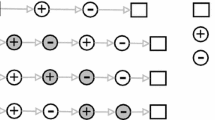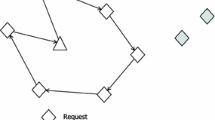Abstract
The exchange of cargo capacities is a well established approach in logistics. However, only few logistics marketplaces are able to take into consideration synergies that can be generated by combining different transportation routes of different logistics carrierps. In order to exploit these synergies, we designed and implemented the combinatorial exchange mechanism ComEx for the intra-enterprise exchange of delivery orders in a logistics company organized in a profit center structure. Each profit center is able to release delivery orders to an adjacent profit center if the geographic locations of the customers allow for a reduced-cost delivery by the adjacent profit center. We demonstrate that by using the ComEx mechanism, the total cost of transportation of our logistics company can be reduced by up to 14%. Since our iterative auction mechanism is very complex and therefore resource-intensive, we reduce the complexity by applying a convex hull approach combined with a distance-based cost estimator.
















Similar content being viewed by others
Notes
In this article, the terms ‘insourcing’ and ‘outsourcing’ are used to describe the exchange of delivery orders between the carriers of a logistics enterprise that is organized in a profit center structure. This use of the terms ‘insourcing’ and ‘outsourcing’ does not exactly correspond with the common definition in IS literature. In order to illustratively describe the exchange mechanism these terms are used in an ‘innovative’ way.
A cost calculation for a single cluster of delivery orders triggers two complete route calculations including and excluding the cluster in the current delivery tour.
References
An N, Elmaghraby W, Keskinocak P (2005) Bidding strategies and their impact on revenues in combinatorial auctions. J Revenue Pricing Manag 3(4):337–357
Bullnheimer B, Hartl R, Strauss C (1999) An improved ant system algorithm for the vehicle routing problem. Ann Oper Res 89:319–328
Cantillon E, Pesendorfer M (2005) Auctioning bus routes: the London experience. In: Steinberg R, Shoham Y, Cramton P (eds) Combinatorial auctions, chap 22. MIT Press, Massachusetts, pp 573–571
Caplice C (1996) An optimization based bidding process: a new framework for shipper-carrierrelationships. PhD thesis, MIT Press, Massachusetts
Caplice C, Sheffi Y (2003) Optimization-based procurement for transportation services. J Bus Logist 24(2):109–128
Cramton P, Shoham Y, Steinberg R (2006) Combinatorial auctions: Introduction. In: Steinberg R, Shoham Y, Cramton P (eds) Combinatorial auctions. MIT Press, Massachusetts, pp 1–13
Cruijssen F, Brysy O, Dullaert W, Fleuren H, Salomon M (2007a) Joint route planning under varying market conditions. Int J Phys Distrib Logist Manag 37(4):287–304
Cruijssen F, Cools K, Dullaert W, Fleuren H (2007b) Horizontal cooperation in logistics: opportunities and impediments. Transp Res Part E Logist Transp Rev 43(2):129–142
Elmaghraby W, Keskinocak P (2005) Combinatorial auctions in procurement. In: Harrison TP, Lee HL, Neale JJ (eds) The practice of supply chain management: where theory and application converge. Springer, Berlin, pp 245–258
Ergun O, Kuyzu G, Savelsbergh MWP (2007a) Bid price optimization for simultaneous truckload transportation procurement auctions. Technical report on Stewart School of Industrial Engineering, Georgia Institute of Technology, Atlanta
Ergun O, Kuyzu G, Savelsbergh MWP (2007b) Reducing truckload transportation costs through collaboration. Transp Sci 41(2):206–221
Ergun O, Kuyzu G, Savelsbergh MWP (2007c) Shipper collaboration. Comput Oper Res 34(6):1551–1560
Glover F (1986) Future paths for integer programming and links to artificial intelligence. Comput Oper Res 13(5):533–549
Goel A, Gruhn V (2007) A general vehicle routing problem. Eur J Oper Res 191:650–660
Gomber P, Schmidt C, Weinhardt C (1999) Auctions in electronic commerce: efficiency versus computational tractability. In: Proceedings of the international conference on electronic commerce 98, Seoul, pp 43–48
Gujo O, Schwind M (2007) Comex: combinatorial auctions for the intra-enterprise exchange of logistics services. In: Proceedings of the 9th international conference on enterprise information systems. Funchal, Madeira, Portugal
Gujo O, Schwind M, Vykoukal J (2007) The design of incentives in a combinatorial exchange for intra-enterprise logistic services. In: Proceedings of the 9th international IEEE conference on E-Commerce technology (CEC’07), IEEE Comp Society, Tokyo, pp 443–446
Houghtalen LM (2007) Designing allocation mechanisms for carrier alliances. Phd thesis, School of Industrial and Systems Engineering, Georgia Institute of Technology, Atlanta
Krajewska MA, Kopfer H (2006) Collaborating freight forwarding enterprises. OR Spectr 28(3):301–436
Krajewska MA, Kopfer H, Laporte G, Ropke S, Zaccour G (2008) Horizontal cooperation of freight carriers: Request allocation and profit sharing. J Oper Res Soc (in press)
Kruskal JB (1956) On the shortest spanning subtree of a graph and the traveling salesman problem. Proc Am Math Soc 7:48–50
Li H, Lim A (2003) Local search with annealing-like restarts to solve the VRPTW. Eur J Oper Res 150:115–127
Nowak M, Ergun O, White CC (2008) Pickup and delivery with split loads. Transp Sci 42(1):32–43
Özener O, Ergun O (2008) Allocating costs in a collaborative transportation procurement network. Transp Sci (in press)
Parkes DC, Kalagnanam J, Eso M (2001) Achieving budget-balance with vickrey-based payment schemes in combinatorial exchanges. In: Proceedigns of the 17th international joint conference on artificial intelligence
Quariguasi JFN, Bloemhof-Ruwaard JM, van Nunen J, van Heck H (2006) Designing and evaluating sustainable logistics networks. Int J Prod Econ 111(2):195–208
Regan A, Song J (2003) An auction based collaborative carrier network. Technical report: UCI-ITS-WP-03-6, Institute of Transportation Studies, University of California, Irvine
Savelsbergh MWP, Sol M (1995) The general pickup and delivery problem. Transp Sci 29:17–29
Schwind M (2005) Design of combinatorial auctions for allocation and procurement processes. In: Proceedings of the 7th international IEEE conference on E-Commerce technology (CEC’05), IEEE Comp Society, München, pp 391–395
Schwind M, Stockheim T, Rothlauf F (2003) Optimization heuristics for the combinatorial auction problem. In: Proceedings of the congress on evolutionary computation (CEC 2003), pp 1588–1595
Schwind M, Gujo O, Stockheim T (2006) Dynamic resource prices in a combinatorial grid system. In: Proceedigns of the 8th international IEEE Conference on E-Commerce technology (CEC’06), San Francisco, CA, IEEE Comp Society, pp 49–53
Slikker M, Fransoo J, Wouters M (2005) Cooperation between multiple news-vendors with transshipments. Eur J Oper Res 167:370–380
Song J, Regan A (2001) Transition or transformation? Emerging freight transportation intermediaries. Transp Res Rec 1763(1):1–5
Stockheim T, Schwind M (2004) Agent-based scheduling in supply chain management. In: Proc of the Sec European Workshop on Multi-Agent Systems (EUMAS 2004), Barcelona, Spain
Vries SD, Vohra R (2001) Combinatorial auctions: a survey. INFORMS J Comput 15(3):284–309
Wendt O (1995) Tourenplanung durch den Einsatz naturanaloger Verfahren: Integration von genetischen Algorithmen und Simulated Annealing. Gabler Verlag, Wiesbaden, Germany
Wendt O, Stockheim T, Weiss K (2005) Intelligente Tourenplanung mit DynaRoute. Wirtsch 47(2):135–140
Wendt O, König W, Stockheim T, Lanninger V, Weiss K (2006) Transportplanung der Zukunft - Prozess- und Kostenanalyse, Optimierungspotenziale und Outsourcing. Books on Demand, Norderstedt, Germany
Xiao F, Yang H (2006) Three-player game-theoretic model over a freight transportation network. Transp Res Part C Emerg Technol 15(4):209–21
Author information
Authors and Affiliations
Corresponding author
Rights and permissions
About this article
Cite this article
Schwind, M., Gujo, O. & Vykoukal, J. A combinatorial intra-enterprise exchange for logistics services. Inf Syst E-Bus Manage 7, 447–471 (2009). https://doi.org/10.1007/s10257-008-0102-4
Received:
Revised:
Accepted:
Published:
Issue Date:
DOI: https://doi.org/10.1007/s10257-008-0102-4




